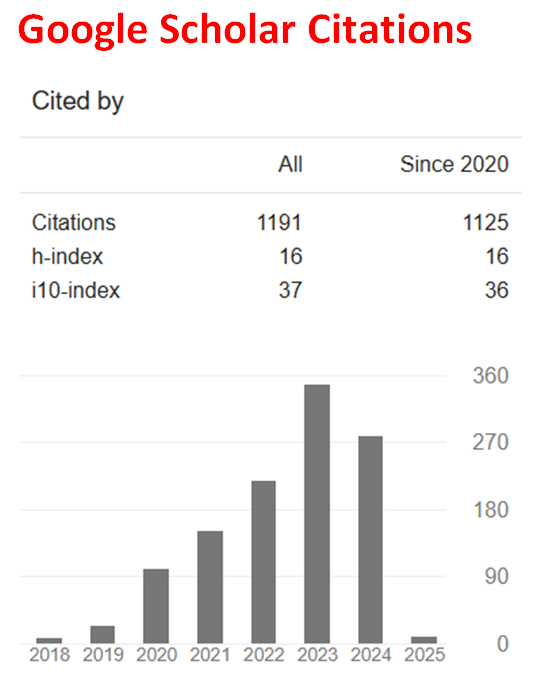An Enhanced Clustering Method for Extending Sensing Lifetime of Wireless Sensor Network
Abstract
Extending the lifetime of a wireless sensor network is vital in ensuring continuous monitoring functions in a target environment. Many techniques have appeared that seek to achieve such prolonged sensing gains. Clustering and improved selection of cluster heads play essential roles in the performance of sensor network functions. Cluster head in a hierarchical arrangement is responsible for transmitting aggregated data from member nodes to a base station for further user-specific data processing and analysis. Minimising the quick dissipation of cluster heads energy requires a careful choice of network factors when selecting a cluster head to prolong the lifetime of a wireless sensor network. In this work, we propose a multi-criteria cluster head selection technique to extend the sensing lifetime of a heterogeneous wireless sensor network. The proposed protocol incorporates residual energy, distance, and node density in selecting a cluster head. Each factor is assigned a weight using the Rank Order Centroid based on its relative importance. Several simulation tests using MATLAB 7.5.0 (R2007b) reveal improved network lifetime and other network performance indicators, including stability and throughput, compared with popular protocols such as LEACH and the SEP. The proposed scheme will be beneficial in applications requiring reliable and stable data sensing and transmission functions.
Downloads
References
K. S. Adu-Manu, N. Adam, C. Tapparello, H. Ayatollahi and W. Heinzelman, Energy-harvesting wireless sensor networks (EH-WSNs): A review, ACM Transactions on Sensor Networks 14(2) (2018), 1-50. https://doi.org/10.1145/3183338
I. F. Akyildiz, W. Su, Y. Sankarasubramaniam and E. Cayirci, Wireless sensor networks: a survey, Computer Networks 38 (2002), 393-422. https://doi.org/10.1016/S1389-1286(01)00302-4
S. Kim, S. Pakzad, D. Culler, J. Demmel, G. Fenves, S. Glaser and M. Turon, Health monitoring of civil infrastructures using wireless sensor networks, IPSN’07: Proceedings of the 6th International Conference on Information Processing in Sensor Networks, 2007, pp. 254-263. https://doi.org/10.1145/1236360.1236395
X. Hu, B. Wang and H. Ji, A wireless sensor network-based structural health monitoring system for highway bridges, Computer-Aided Civil and Infrastructure Engineering 28(3) (2013), 193-209. https://doi.org/10.1111/j.1467-8667.2012.00781.x
S. El Khediri, N. Nasri, A. Wei and A. Kachori, A new approach for clustering in wireless sensors networks based on LEACH, Procedia Computer Science 32 (2014), 1180-1185. https://doi.org/10.1016/j.procs.2014.05.551
H. Gou and Y. Yoo, An energy balancing LEACH algorithm for wireless sensor networks, Seventh International Conference on Information Technology: New Generations, 2010, pp. 822-827. https://doi.org/10.1109/ITNG.2010.12
S. Lindsey and C. S. Raghavendra, PEGASIS: Power-efficient gathering in sensor information systems, Proceedings, IEEE Aerospace Conference, 2002. https://doi.org/10.1109/AERO.2002.1035242
S. D. Muruganathan, D. C. F. Ma, R. I. Bhasin and A. O. Fapojuwo, A centralised energy-efficient routing protocol for wireless sensor networks, IEEE Communications Magazine 43(3) (2005), 8-13. https://doi.org/10.1109/mcom.2005.1404592
A. A. Abbasi and M. Younis, A survey on clustering algorithms for wireless sensor networks, Computer Communications 30 (2007), 2826-2841. https://doi.org/10.1016/j.comcom.2007.05.024
W. R. Heinzelman, A. Chandrakasan and H. Balakrishnan, Energy-efficient communication protocol for wireless microsensor networks, Proceedings of the 33rd Annual Hawaii International Conference on System Sciences, 2000. https://doi.org/10.1109/hicss.2000.926982
G. Smaragdakis, I. Matta and A. Bestavros, SEP: A stable election protocol for clustered heterogeneous wireless sensor networks, Journal of Innovative Research in Computer and Communication Engineering 4(6) (2004), 54-59.
C. Divya, N. Krishnan and T. Gandhi, Energy efficient stable election protocol for clustered heterogeneous wireless sensor networks, IOSR Journal of Computer Engineering (IOSR-JCE) 12(5) (2013), 55-61. https://doi.org/10.9790/0661-1255561
G. Arya and D. S. Chauhan, Modified stable election protocol (M-SEP) for hierarchical WSN, International Journal of Computer Applications 79(16) (2013), 35-39. https://doi.org/10.5120/13947-1926
R. Verma, P. Dolly and D. Kumar, A novel approach of improved stable election protocol (I-SEP) in WSN, International Journal of Innovative Research in Computer and Communication Engineering 4(6) (2015), 54-59.
L. J. P. Jeevan and D. H. Manjaiah, Modified enhanced stable election based routing protocol for wireless sensor networks, International Journal of Innovative Research in Computer and Communication Engineering 2(5) (2014), 54-59.
S. Faisal, N. Javaid, A. Javaid, M. A. Khan, S. H. Bouk and Z. A. Khan, Z-SEP: Zonal-stable election protocol for wireless sensor networks, 2013. http://arxiv.org/abs/1303.5364
F. Jibreel, M. I. Daabo and K. A. Gbolagade, Gateway-stable election protocol for heterogeneous wireless sensor network, Asian Journal of Research in Computer Science 5(1) (2020), 40-48. https://doi.org/10.9734/ajrcos/2020/v5i130127
E. Roszkowska, Rank ordering criteria weighting methods – a comparative overview, Optimum. Studia Ekonomiczne 5(65) (2013), 14-33. https://doi.org/10.15290/ose.2013.05.65.02

This work is licensed under a Creative Commons Attribution 4.0 International License.
.jpg)

